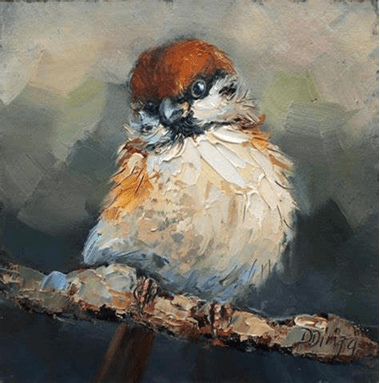Birds have long been a favorite subject of artists, capturing their grace, vibrant colors, and intricate feather patterns in stunning detail. Classical oil painting techniques provide an excellent medium for naturalist bird portraiture, offering rich textures, depth, and realism. In this blog post, we will explore the fundamentals of classical oil painting for bird portraiture, including materials, techniques, and artistic considerations.
Materials for Classical Oil Painting
To create a high-quality bird portrait using oil paints, you will need the following materials:
- Oil Paints: A high-quality artist-grade oil paint set with a range of colors, including earth tones and vibrant hues for accurate bird coloration.
- Canvas or Wooden Panel: A fine-textured canvas or a primed wooden panel provides a stable surface for detailed work.
- Brushes: A selection of brushes, including fine liners for intricate feather details and larger brushes for background blending.
- Oil Mediums: Linseed oil or walnut oil to adjust paint consistency and drying time.
- Palette: A wooden or glass palette for mixing colors.
- Turpentine or Odorless Mineral Spirits: Used for thinning paint and cleaning brushes.
- Varnish: A final protective coating to preserve the painting’s vibrancy.
Techniques for Bird Portraiture
1. Underpainting and Sketching
Begin by sketching the bird’s outline using a graphite pencil or a thin layer of diluted oil paint. Use an earth-tone color for the underpainting to establish the composition and tonal values.
2. Blocking in Colors
Apply the base colors of the bird and background with broad, loose brushstrokes. Focus on capturing the general color and form rather than fine details at this stage.
3. Layering and Glazing
Oil painting allows for multiple layers, creating depth and translucency. Use glazes (thin, transparent layers of paint) to refine colors and add a luminous effect to feathers.
4. Detailing Feathers and Features
Use fine brushes and delicate strokes to paint individual feathers, taking note of direction and texture. Pay special attention to the eyes, as they bring life and expression to the portrait.
5. Background and Composition
A complementary background enhances the bird’s presence. Soft, blurred backgrounds suggest a natural habitat without overpowering the subject.
6. Finishing Touches and Varnishing
Once dry, add final highlights and details. Allow the painting to dry completely before applying varnish to protect it from dust and aging.
Artistic Considerations
- Observation and Reference: Study bird anatomy, feather patterns, and lighting by observing birds in nature or using high-quality reference photos.
- Color Harmony: Maintain a balanced palette that complements the bird’s natural tones.
- Mood and Expression: A well-executed bird portrait captures not only physical beauty but also the spirit and personality of the subject.
Conclusion
Classical oil painting is a rewarding technique for naturalist bird portraiture, allowing artists to create stunning, lifelike representations of avian subjects. With patience, practice, and an understanding of materials and techniques, artists can bring the beauty of birds to life on canvas. Whether painting for artistic expression or scientific documentation, this timeless art form continues to celebrate the wonders of the natural world.

